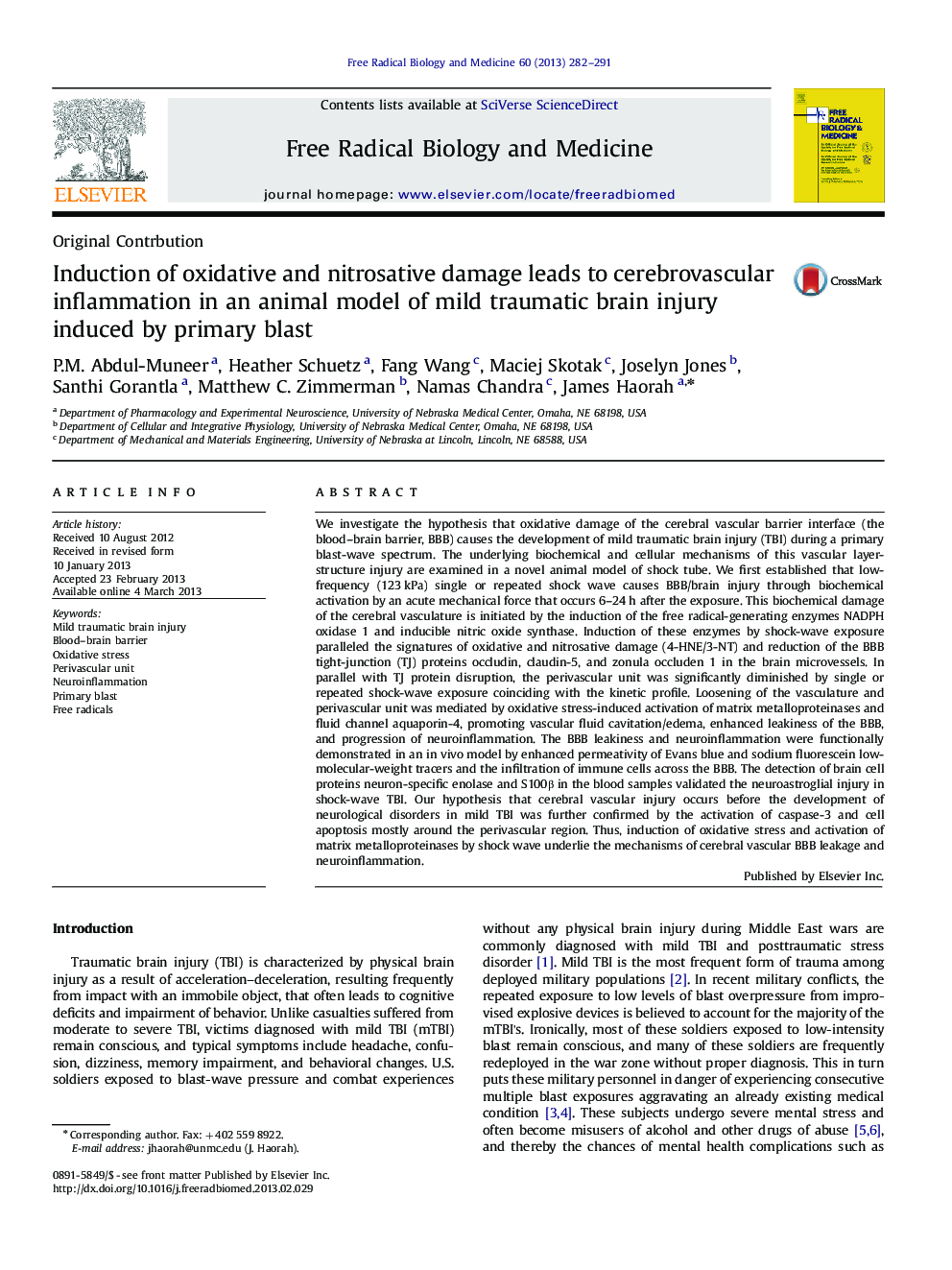| کد مقاله | کد نشریه | سال انتشار | مقاله انگلیسی | نسخه تمام متن |
|---|---|---|---|---|
| 8271625 | 1534982 | 2013 | 10 صفحه PDF | دانلود رایگان |
عنوان انگلیسی مقاله ISI
Induction of oxidative and nitrosative damage leads to cerebrovascular inflammation in an animal model of mild traumatic brain injury induced by primary blast
ترجمه فارسی عنوان
القاء آسیب اکسیداتیو و نیتروژن به التهاب مغزی در مدل حیوانی آسیب مغزی آسیبدیده ناشی از انفجار اولیه منجر می شود
دانلود مقاله + سفارش ترجمه
دانلود مقاله ISI انگلیسی
رایگان برای ایرانیان
کلمات کلیدی
موضوعات مرتبط
علوم زیستی و بیوفناوری
بیوشیمی، ژنتیک و زیست شناسی مولکولی
سالمندی
چکیده انگلیسی
We investigate the hypothesis that oxidative damage of the cerebral vascular barrier interface (the blood-brain barrier, BBB) causes the development of mild traumatic brain injury (TBI) during a primary blast-wave spectrum. The underlying biochemical and cellular mechanisms of this vascular layer-structure injury are examined in a novel animal model of shock tube. We first established that low-frequency (123 kPa) single or repeated shock wave causes BBB/brain injury through biochemical activation by an acute mechanical force that occurs 6-24 h after the exposure. This biochemical damage of the cerebral vasculature is initiated by the induction of the free radical-generating enzymes NADPH oxidase 1 and inducible nitric oxide synthase. Induction of these enzymes by shock-wave exposure paralleled the signatures of oxidative and nitrosative damage (4-HNE/3-NT) and reduction of the BBB tight-junction (TJ) proteins occludin, claudin-5, and zonula occluden 1 in the brain microvessels. In parallel with TJ protein disruption, the perivascular unit was significantly diminished by single or repeated shock-wave exposure coinciding with the kinetic profile. Loosening of the vasculature and perivascular unit was mediated by oxidative stress-induced activation of matrix metalloproteinases and fluid channel aquaporin-4, promoting vascular fluid cavitation/edema, enhanced leakiness of the BBB, and progression of neuroinflammation. The BBB leakiness and neuroinflammation were functionally demonstrated in an in vivo model by enhanced permeativity of Evans blue and sodium fluorescein low-molecular-weight tracers and the infiltration of immune cells across the BBB. The detection of brain cell proteins neuron-specific enolase and S100β in the blood samples validated the neuroastroglial injury in shock-wave TBI. Our hypothesis that cerebral vascular injury occurs before the development of neurological disorders in mild TBI was further confirmed by the activation of caspase-3 and cell apoptosis mostly around the perivascular region. Thus, induction of oxidative stress and activation of matrix metalloproteinases by shock wave underlie the mechanisms of cerebral vascular BBB leakage and neuroinflammation.
ناشر
Database: Elsevier - ScienceDirect (ساینس دایرکت)
Journal: Free Radical Biology and Medicine - Volume 60, July 2013, Pages 282-291
Journal: Free Radical Biology and Medicine - Volume 60, July 2013, Pages 282-291
نویسندگان
P.M. Abdul-Muneer, Heather Schuetz, Fang Wang, Maciej Skotak, Joselyn Jones, Santhi Gorantla, Matthew C. Zimmerman, Namas Chandra, James Haorah,
